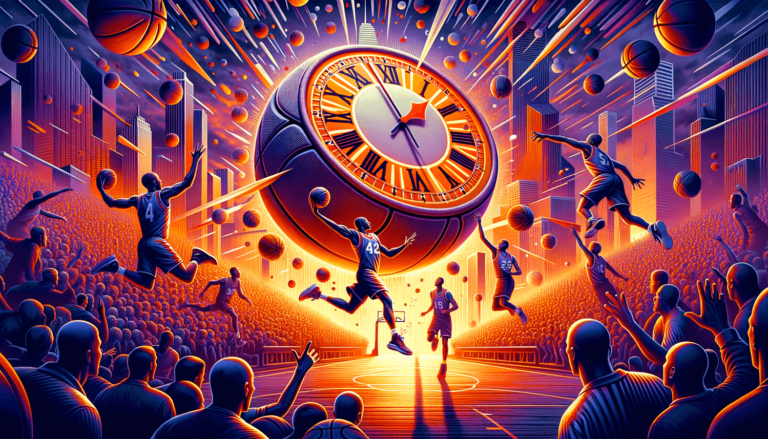
Basketball’s Running Clock Rule: What It Means and When It’s Used
Written by: Basketball Universe
Last updated:

For many hoop fanatics, the thrill of the game lies in the intensity built by tension-filled seconds as the game’s conclusion draws near. Understanding the rules and intricacies of basketball truly enhances the experience. One often debated and intriguing rule is the ‘Running Clock Rule.’ This might sound like a never-stopping, unrelenting clock that keeps time moving back and forth on the court, but it’s a little bit more than that. In this fun and informative blog post, we’re going to break down everything you need to know about basketball’s Running Clock Rule, demystifying when it’s used and what it means for the game. So tighten your sneakers, and let’s dive into the world of seconds, points, and fast-paced sport!
Basketball’s Running Clock Rule: What It Means and When It’s Used
The Running Clock Rule in basketball refers to a game situation where the clock continues to run during play, minimizing stoppages in an effort to shorten the game’s duration without impacting its competitive nature. Used primarily in youth, recreational, or blowout games, the rule is implemented when a significant point differential exists between the two competing teams or when both teams agree to it prior to the game. This helps maintain a fluid game pace and provides a practical approach to managing playing time.
Exploring the Running Clock Rule in Basketball
Before we dive into how the Running Clock Rule is implemented and the variations across different levels of play, it’s essential to gain an understanding of what the rule is really about. Simply put, the Running Clock Rule is designed to ensure that certain basketball games don’t drag on indefinitely when there is a significant point difference or blowout between the two teams.
Running Clock Rule Across Different Levels of Play
While the basic concept remains consistent across different segments of the basketball universe, it is the specifics of the Running Clock Rule that may differ from one league to another. The rule’s application may vary depending on age, skill level, or the governing body overseeing the basketball league or tournament. Below, we discuss several instances in which the Running Clock Rule is utilized.
Youth and Recreational Leagues
Younger kids just starting out in the world of basketball are in it for the fun of the game and to develop their skills. In youth and recreational leagues, the emphasis is on sportsmanship and fostering a love for the sport, rather than focusing on cutthroat competition. To keep the game enjoyable and prevent young athletes from getting discouraged, the Running Clock Rule is widely adopted in these leagues to maintain a comfortable pace and offer equal playing time for each participant.
High School Basketball
In high school basketball, running clocks are often employed to prevent lopsided games from extending unnecessarily. Numerous states across the USA have adopted this rule to strike a balance between maintaining a competitive atmosphere and ensuring player safety, minimizing the risks associated with extended periods of play. However, it is crucial to note that the point differential required to activate a running clock may vary from state to state, so familiarizing oneself with local basketball rules is essential.
College Basketball
While the Running Clock Rule is less commonly used in college basketball, it may still be encountered during pre-season tournaments or similar events where a distinctive point difference exists between competing programs. When this rule comes into play, it often aims to preserve the players’ welfare and keep the contest moving at a manageable pace.
Professional Basketball and Overseas Leagues
In professional basketball leagues and most overseas circuits, the Running Clock Rule is less prevalent. Generally, these leagues rely on their specific governing bodies’ basketball rules – such as FIBA or NBA – to address the need for running clocks in particular circumstances. However, running clocks are still occasionally seen in exhibition games or friendly matchups between teams from different countries or leagues.
Variations of the Running Clock Rule in Basketball
As previously mentioned, the specifics of the Running Clock Rule vary across different levels of play and regions. When analyzing any set of basketball rules, it’s essential to understand how these variations work and when they come into effect.
Point Differential Threshold
Typically, a running clock is triggered when a particular point differential between the two teams is reached. This threshold varies, as some leagues require a 20 or 30-point difference, while others may use a higher benchmark. Once the point differential dips below the stipulated threshold, normal clock rules generally resume, unless the league has stipulations about the time left in the game.
No-clock Conditions
In certain scenarios or basketball events, a running clock may be utilized as the primary clock operation method throughout the entire game. This approach keeps games at a swift, consistent pace and can be a practical alternative when a large number of games must be played within a limited timeframe.
Agreed-upon Modifications
There may also be situations where both teams agree, either before or during a game, to switch from regular clock operations to a running clock format. This agreement could stem from multiple reasons, such as player welfare, severe weather conditions, or limited venue availability.
Period-based Adjustments
In some leagues or tournaments, the Running Clock Rule may only apply to specific periods or segments of a game – usually during the latter half or the final quarter. This selective application allows for tighter control over the game proceedings while maintaining a sense of excitement during the game’s earlier stages as the teams jostle for the lead.
Understanding Clock Stops and Running Clock Exceptions
While the Running Clock Rule is mainly intended to keep the game progressing continuously, there are instances when the clock does stop, even under this rule. Familiarizing oneself with these exceptions is key to comprehending a running clock game properly.
Timeouts
One of the most apparent stoppage scenarios during a running clock game is when a team calls for a timeout. In this case, the clock will pause to accommodate the allotted timeout duration, allowing players and coaches to regroup and discuss strategy. After the designated timeout duration, the clock resumes its non-stop operation.
Injuries and Delays
Player safety is paramount in any sport, and basketball is no exception. When a player becomes injured or a similar delay occurs, such as a wet floor or equipment malfunction, the clock will stop to address the situation. Once the issue has been resolved, the running clock operation recommences.
Free-throw Attempts
In certain leagues or specific games, the Running Clock Rule might demand clock stoppages during free-throw attempts. As these pauses are essential in enabling players to focus on their shots, understanding how this provision affects the game’s overall pace is critical.
Substitutions
Player substitutions can also lead to temporary clock stoppages during a running clock game. This rule is especially applicable in youth, recreational, or developmental leagues, where the emphasis is on providing equal playing time for all players, allowing coaches to execute substitution rotations efficiently.
Strategic Implications of the Running Clock Rule
The Running Clock Rule brings more than just fluidity to a basketball game – it also influences the strategies employed by both teams competing in such a match. Here are several strategic implications that emerge when a game operates with a running clock:
Managing Fatigue and Rotations
With the clock running continuously, coaches need to keep a watchful eye on player fatigue levels and ensure optimal rotation strategies. A fatigued player may not contribute effectively to the team’s performance or might even become prone to injury. Efficient player management becomes more critical during running clock games to preserve the team’s energy and maintain competitiveness throughout the game.
Adjusting Offensive and Defensive Preferences
The limited clock stoppages in a running clock game may necessitate teams to adjust their offensive and defensive styles. For example, a team that typically relies on a fast-break offense might consider a more controlled, half-court offensive approach to save energy and better manage the game clock. Similarly, defensive schemes may require tweaking to account for adjustments made by the opposing team.
Disrupting Opponent’s Rhythm
Running clock games present opportunities for teams to disrupt their opponents’ rhythm or make it harder for them to mount comebacks. Savvy coaches will exploit the non-stop clock to their advantage by implementing strategies that can frustrate the opposing team and prevent them from regaining momentum, ultimately increasing their chances of securing a victory.
Key Takeaways: Navigating the Running Clock Rule in Basketball
The Running Clock Rule is a critical aspect of understanding basketball rules, as it influences how different leagues and levels handle game flow and strategy. Familiarizing oneself with the various nuances and applying that knowledge during games can significantly enhance the overall enjoyment of the sport and enable players, coaches, and fans to make informed decisions about situations that may arise during matches with running clocks. A strong grasp of the Running Clock Rule can ultimately contribute to a more comprehensive and fulfilling basketball experience.
Dealing with Running Clock Rule Controversy
As with many sports rules, the Running Clock Rule in basketball has its fair share of controversy. There are those who argue that this rule diminishes the excitement and competitiveness of the game, while others contend that the rule serves the essential purpose of managing time, ensuring player welfare, and fostering a more sportsmanlike environment. To better understand this debate, let’s take a look at some of these differing opinions.
The Case for the Running Clock
On one side of the debate, advocates for the Running Clock Rule often suggest that the primary goal of this provision is to promote fair play and the enjoyment of the sport, particularly in amateur and youth leagues. They believe that by implementing a running clock, games with significant point differentials or blowouts can be brought to a more palatable and timely conclusion, ensuring that overmatched teams aren’t further demoralized and preventing unfortunate incidents or more significant injuries from occurring.
The Case against the Running Clock
On the other hand, there are those who argue that employing a running clock undermines the competitive aspect of the game and prevents opportunities for skill development for players on both teams. They contend that large point differentials are part of the natural ebb and flow of sports, and that by limiting the clock in certain situations, decision-makers are essentially deciding the outcome of games prematurely. As a result, they feel competitiveness is compromised, and players can’t learn valuable lessons from these experiences that can help them grow as athletes.
Finding the Middle Ground
As with most contentious issues, finding a middle ground often proves the most challenging aspect. While the Running Clock Rule may not be universally loved, some agree that a well-structured application can provide benefits in specific situations without sacrificing the core of the sport.
Implementing a Sliding Scale
One possible solution involves employing a sliding scale to determine when a running clock should be used during games, with adjustments based on various factors such as age, skill level, or the league in question. This approach ensures that the rule is only applied when circumstances truly warrant the intervention, helping referees and decision-makers avoid unfairly influencing the outcome of games.
Flexible Application
Another point of consensus that might be reached is to use a flexible application of the Running Clock Rule, allowing it to kick in under specific conditions and perhaps only after a certain point in the game. This approach would not limit the competitiveness in the earlier phases of the match, but rather offer a more practical solution during the latter stages when excessive point differentials may otherwise hinder enjoyment or player development.
Continuing the Conversation
Ultimately, the Running Clock Rule remains a divisive topic, with valid arguments on both sides. It is vital that leagues, governing bodies, and stakeholders within the basketball community continue the conversation with an open mind and work together to find the most suitable solutions that uphold the spirit of the game while protecting the welfare and development of athletes. This approach will ensure that any adjustments made to the Running Clock Rule or other basketball rules reflect the evolving understanding of what makes the sport so great.
FAQ: Everything You Need to Know About the Running Clock Rule
Got questions about the Running Clock Rule in basketball? You’re not alone! We’ve compiled a list of frequently asked questions to help you gain a clearer understanding of this fascinating rule and its impact on the game. Read on to explore these common inquiries and broaden your basketball knowledge.
1. Is the Running Clock Rule utilized in professional basketball games?
While not common, the Running Clock Rule is sometimes used in professional basketball exhibition games or friendly matchups. However, it’s rarely implemented during competitive games in leagues such as the NBA or FIBA-regulated overseas competitions.
2. What constitutes a “blowout” in basketball?
A blowout typically refers to a game in which one team holds a significant lead over their opponent throughout the entire match, resulting in a lopsided final score. The term is subjective, and the point differential suggestive of a blowout can vary depending on the league or skill level.
3. How does a running clock impact the overall pace of the game?
A running clock contributes to a faster-paced, less interrupted game by keeping the clock in motion without stopping during many of the usual scenarios that cause stoppages, such as out-of-bounds plays or fouls. The result is a more fluid and time-efficient game.
4. In which period(s) is the Running Clock Rule usually applied?
The Running Clock Rule can be applied during specific periods of a game depending on the league rules or level of competition. Generally, it’s more likely to be triggered in the second half or the final quarter, especially if a significant point differential exists between the two teams.
5. Can the Running Clock Rule be revoked during a game?
Yes, depending on the specific league rules or agreements made before the game, the Running Clock Rule may be revoked if the point differential dips below the stipulated threshold, allowing for a return to regular stoppages. However, some leagues may maintain the running clock regardless of the point differential, based on time left in the game.
6. Are there any downsides to using a running clock in basketball games?
Some critics argue that the Running Clock Rule undermines competitiveness and obstructs skill development opportunities for players on both teams. They believe large point differentials are natural occurrences within sports and shouldn’t be artificially minimized by employing a running clock.
7. How can a coach strategically adapt to a game with a running clock?
A coach can adapt by efficiently managing player fatigue and rotations, adjusting offensive and defensive strategies according to the game’s pace and opponents, and capitalizing on non-stop clock scenarios to disrupt the opposing team’s rhythm and thwart their comeback attempts.
8. Are there variations in the Running Clock Rule depending on the level of play?
Yes, the Running Clock Rule’s application and specifics can vary based on the level of play (youth, recreational, high school, college, professional) and the governing body of the basketball league or tournament in question. This might include differences in point differential thresholds, clock stoppages for free throws, or agreed-upon modifications.
9. How do different leagues regulate the Running Clock Rule?
Leagues regulate the Running Clock Rule by establishing clear guidelines specifying when and how it should be applied during games. These guidelines might involve point differential thresholds, quarter-based restrictions, pre-match agreements, and provisions for revoking or adjusting the running clock under certain conditions.
10. What is the main purpose of the Running Clock Rule in basketball?
The Running Clock Rule is meant to keep games moving at a steady pace and bring contests with significant point differentials or blowouts to a more timely resolution without compromising the players’ welfare or discouraging competition among participants, especially in amateur or youth leagues.
Featured Posts
- No pillar pages found.





